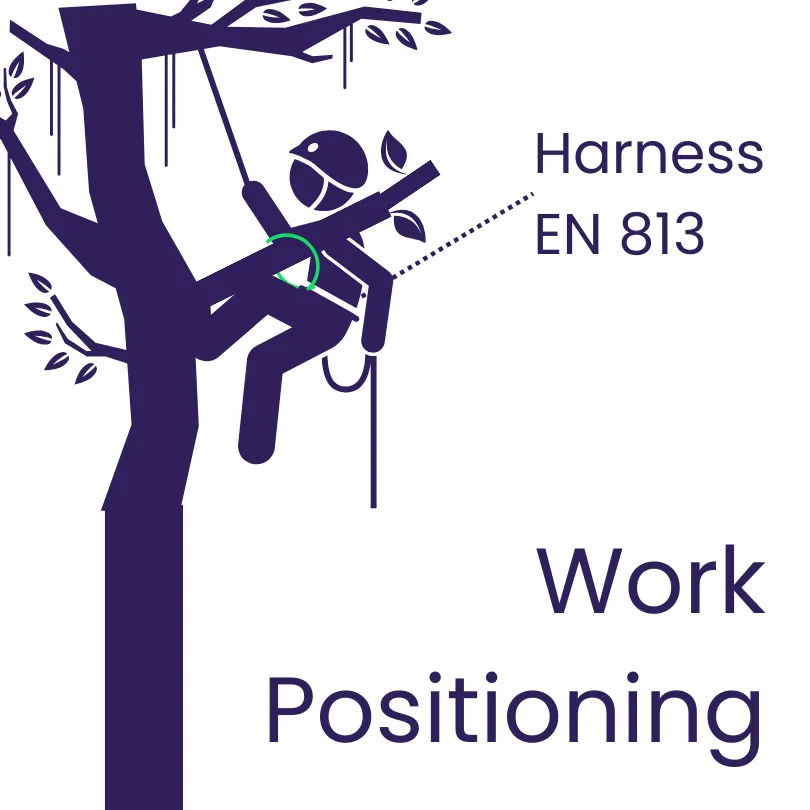.webp)

About the author:
Jess Garland is a former IRATA Level 3 rope tech, she spent 9 years dangling from ropes on a wide variety of sites before hanging up her harness to start a family. She continues to use her practical experience from a keyboard with Scannable.
We should begin by acknowledging that working at height poses risks. A passive system or options to complete a job from a fixed or temporary work platform should be explored before getting on the ropes. That said, it isn't always possible or practicable to avoid working at height.
Let's look at the differences of each, and why it is important to distinguish between them - not only for rigging appropriately, but for selecting the correct PPE for the job and rescue scenario.
It isn't safe to use a harness designed for work positioning in a fall arrest scenario, for example. This is because different harnesses are designed for different jobs, and meet different safety standards.
One of our driving forces at Scannable is to make working at height safer, because safety matters. Falls from height are one of the leading causes of death in the workplace, sadly most accidents involve people who are not well trained or competent in working at height.
25 percent of deaths due to workplace accidents in the UK in the year 2020-2021 were from a fall at height. This was the leading cause of death. Statistics from many other countries in the developed world tell the same story.
.webp)
Firstly, there is some naivety around what constitutes work at height. Without sufficient training, people are not aware that any work where there is a potential fall distance of 1.8 metres or more, or within 2.0 metres of an unguarded edge is work at height.
Secondly, in the construction industry, a one-day height safety course every two years deems a person competent to put a harness on and know what they are doing when it comes to fall restraint or fall arrest and rescue.
YouTube is riddled with videos of ‘the ABC’s of height safety’, many with misguided information around the correct PPE.
When there’s some confusion around the differences in PPE for competent people who work in the job every day as arborists or riggers, rope access or rescue, it’s not surprising that so many deaths happen in construction where workers lack sufficient experience or training to make decisions around working at height.
Let's look at the three work types in order of safety:

A fall restraint system prevents the user from reaching a fall hazard area by ensuring that the length of a fully extended lanyard is shorter than the distance to any edge. This allows a worker to undertake his duties without the risk of falling - a flat roof where work near the edge is required, for example.
A fall restraint system allows them to access the work area, but the risk of falling off the building is removed.
A harness for fall restraint must meet EN 358 (restraint belts and lanyards) or equivalent. The lanyard should meet EN 354, and the anchor point should meet EN 795.
If buying a harness specifically for fall restraint, we think something that isn’t too bulky would be beneficial. Some manufacturers even build them into high-vis clothing.

A work positioning system enables a worker to be held in tension or suspension while supported by a harness.
An abseiler who rappels down ropes to access the work area, people working on transmission towers who are suspended from the structure, or arborists who are working in the limbs of a tree are all examples of a work positioning system in use.
Work positioning harnesses may be a sit harness or full body harness, depending on the nature of the work. There must be little or no slack in the system (less than 600mm) to minimise the consequences of a fall.
This includes the use of dynamic rope for lanyards used by arborists and rope techs for aid climbing, and any horizontal lines above a technician’s harness attachment point to ensure little or no slack.
A harness for this application should be certified and tested against the European standard EN 358 or equivalent. After that, it's a case of working out what other features will be useful.
All lanyards must conform to EN 358, while anchors must meet EN 795.
A harness rated to EN 813 (seat harness), EN 358 (belts for work positioning and restraint) and EN 361 (full body harness-fall protection) are the all-rounders of fall protection. Most harnesses designed for rope access work and rigging meet all three standards, or equivalent.
Arborist harnesses are usually certified to EN 813 (seat) and EN 358 (work positioning and restraint). As tree care workers usually operate on a single line, their harnesses come with features not found on rope access harnesses.
A sliding rope bridge functions as the attachment point of the harness, giving the worker a huge range of movement and the ability to work in trees without hindrance.
Work positioning harnesses also have two lateral eyelets, so that they can be secured with lanyards or other connecting elements for work positioning while maintaining a good range of movement.
The Australian/New Zealand standard AS/NZS 1891.1, (2007 edition) is equivalent to EN 354, EN 358 and EN 361 combined.

The last in the hierarchy of control is fall arrest. Fall arrest does not prevent a free fall, but is designed to reduce the consequences of a fall by limiting the distance and impact force. This could be with a self retracting lifeline (EN 360), or an energy absorbing lanyard (EN 355).
Any harness used for fall arrest should meet EN 361 (full body harness - fall protection) and workers should be attached to the anchor by either the sternal or dorsal D ring so that their body is held upright in the case of a fall.
It is also important to understand how energy absorbing lanyards work (EN 355).
Part of an energy absorbing lanyard’s webbing is stitched together. When loaded with the impact of a fall, the stitching tears, and the energy absorber’s webbing limits the impact force on the user. Needless to say, the lanyard is longer after it has been deployed.
A crucial step before using a fall arrest system is to determine if there is enough clearance in the fall area for the full length of the lanyard. This is why arborists don’t use fall arrest systems, as there is generally not enough clearance in trees.
Rescues in fall arrest scenarios are often not planned practically enough, even if the boxes are ticked on the paperwork. When someone falls under fall arrest the rescue can be complicated. It is important to practice so that rescues are fast and safe in a real life scenario.
All people undertaking work at height should be trained and competent. PPE must be well fitting, and equipment should be well maintained and inspected with a record of such.
While we’ve covered the different standards of harnesses for different types of work scenarios in this blog, it’s also very important to protect your head! Please have a read of our blog Making Sense of Helmet Standards if you’re not sure that your helmet is suitable for working at height.